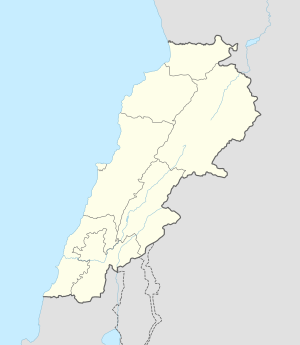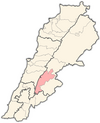Qaraoun
Qaraoun | |
|---|---|
Village | |
 Lake Qaraoun or Lake Litani, upstream of Qaraoun village in the Beqaa Valley in Lebanon | |
| Coordinates: 33°33′48″N 35°43′19″E / 33.56333°N 35.72194°E | |
| Country | |
| Governorate | Beqaa Governorate |
| District | Western Beqaa District |
| Area | |
| • Village | 5.64 sq mi (14.60 km2) |
| • Land | 5.64 sq mi (14.60 km2) |
| • Urban | 1.4 sq mi (3.6 km2) |
| Elevation | 2,600 ft (800 m) |
| Population | |
| • Village | 7,000 |
Qaraoun is a Lebanese village, 85 km from Beirut, known for its Lake Qaraoun in the Beqaa Valley formed by the El Wauroun Dam built in 1959. It is an ecologically fragile zone in the Western Beqaa District.[1] The village lies about 800 m above sea level.[2] The dam is located nearby on the Litani River.[2]
Geography
The village is delimited by Majdel Balhis on the east, Aitanite on the west, Baaloul on the north and Sohmor on the south. The ecoregion of the village has now a land area of 1460 ha, with 1100 ha of it under agriculture including 400 ha under irrigation and the balance agricultural area is rainfed. When the El Qauroun Dam was built on the Litani River (the longest river in Lebanon) in 1959, Qaraoun village, lying on its left bank transferred an area of 740 ha for the development of the project. The ecoregions habitat composition is a delicate interface of dry lands with the riverine and lacustrine zones.[1]
Demographics, economy and development
The population of the village is around 7,000.[1]
The development activity near the village, consequent to land area the Qaraoun village transferred for building of the El Qaraoun Dam in the middle reaches of the Litani River, which created an artificial lake (33°34′11.63″N 35°41′51.18″E / 33.5698972°N 35.6975500°E) with water spread area of 1190 ha (the largest body of freshwater in Lebanon). The dam, which created the artificial lake or reservoir, is the largest dam built in Lebanon for multipurpose uses of hydropower generation (190 MW), irrigation (28,500 ha) and drinking water supply. It is a concrete-faced rockfill dam (CFRD) of 61 m height built with crest level at EL 801 m with a dam length of 1090 m, over karstic limestone formations. The reservoir has a storage capacity of 220 million cubic metres at maximum pond elevation of 858 m.[3]
The lake environment includes woodland, orchards and low-growing scrubs; it attracts about 20,000 migratory birds such as
Archaeology

The town gives its name to the
There are several archaeological sites in the area.Qaraoun I (Left Bank)
Qaraoun I is a
Qaraoun II (Right Bank)
Qaraoun II is the
Qaraoun III (Ain el Barde)
Qaraoun III is 300 m northwest of the village, on the left bank of the river near the track going south towards
Henri Fleisch remarked in a personal communication with Lorraine Copeland that several other prehistoric sites exist in the same area, but with smaller amounts of material.[10]
In February 2003, heavy rainfall in the southern
References
- ^ a b c d "Qaraoun Village". aub.edu.lb. Retrieved 23 April 2011.
- ^ a b Center for Economic; Financial and Social Research and Documentation (1978). The Arab economist. Center for Economic, Financial and Social Research and Documentation. Retrieved 23 April 2011.
- ^ International Commission on Large Dams; International Association for Hydraulic Research; International Commission on Irrigation and Drainage (2008). International journal on hydropower & dams. Aqua-Media International. pp. 76–77. Retrieved 24 April 2011.
- ^ "Lake Qaraoun". Birdlife.org. Retrieved 24 April 2011.
- ^ Lorraine Copeland; P. Wescombe (1965). Inventory of Stone-Age sites in Lebanon, p. 43. Imprimerie Catholique. Retrieved 21 July 2011.[permanent dead link]
- ^ Fleisch, Henri., Nouvelles stations préhistoriques au Liban, Bulletin de la Société Préhistorique Française, vol. 51, pp. 564-565, 1954.
- ^ a b c Fleisch, Henri., Nouvelles stations préhistoriques au Liban. BSPF, vol. 51, p. 564, 1954.
- ^ a b Cauvin, Jacques., Le néolithique de Mouchtara (Liban-Sud). L'Anthropologie, vol. 65, 1-2, p. 72 & 509
- ^ a b Moore, A.M.T. (1978). The Neolithic of the Levant. Oxford University, Unpublished Ph.D. Thesis. pp. 434–444.
- ^ a b c L. Copeland; P. Wescombe (1966). Inventory of Stone-Age Sites in Lebanon: North, South and East-Central Lebanon, p. 37-38. Impr. Catholique. Retrieved 29 August 2011.
- ^ Fleisch, Henri., Préhistoire au Liban en 1950, BSPF, vol. 48, 1-2, p. 26, 1951
- ^ Fleisch, Henri., Les industries lithiques récentes de la Békaa, République Libanaise, Acts of the 6th C.I.S.E.A., vol. XI, no. 1, Paris, 1960
- ^ ISBN 978-1-84217-132-5.
- ^ Van Liere, W. & Contenson, Henri de., A note on 5 early Neolithic sites in inland Syria, AAS, vol. 13, p. 179, 1963
- ^ Mellaart, James, Earliest Civilizations in the Near East, Thames and Hudson, London, 1965.
External links
- Qaraaoun, Localiban


